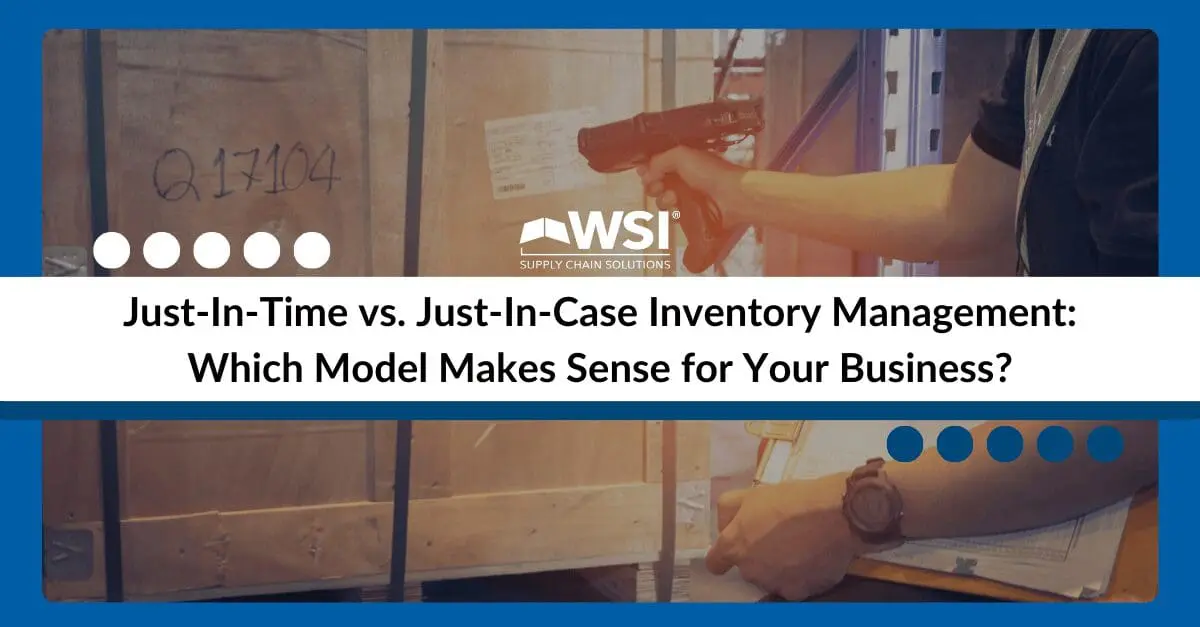Which inventory management strategy you choose directly impacts your business’s overall success and health. It affects customer satisfaction, business costs, cash flow, profits, inventory management, and operational efficiency.
Continually shifting market, economic, and geopolitical conditions are causing businesses to reassess their strategy. Two popular strategies, just-in-time (JIT) and just-in-case (JIC) are top candidates.
While both models have their benefits, they address different operational needs. Determining the right approach depends on your business goals, market dynamics, and risk tolerance.
In this blog, we provide a brief overview of JIT and JIC, compare the two strategies, clarify considerations for which model is best for your business, and propose a potential hybrid option.
Condensed Overview of JIT and JIC
First, let’s briefly review what JIT and JIC inventory management are.
Just-In-Time (JIT): This model focuses on minimizing inventory levels by receiving goods only as they are needed for production, reducing waste and storage costs. This strategy is best suited for businesses with predictable demand and stable supply chains.
Just-In-Case (JIC): In contrast, JIC involves holding extra inventory to protect against uncertainties in demand or supply chain disruptions. This model is ideal for businesses with unpredictable demand or longer lead times.
Compare and Contrast: JIT vs. JIC Inventory Management
JIT and JIC both have benefits and drawbacks. Comparing them will help you weigh your options as you adjust your business’ inventory management strategy.
- Risk Management: JIC offers a buffer against supply chain disruptions and ties up capital in inventory. On the other hand, JIT reduces inventory costs and makes businesses more vulnerable to stockouts.
- Cost Efficiency: JIT minimizes holding costs and waste by aligning inventory with immediate needs, while JIC can lead to higher storage costs and provides flexibility during demand fluctuations.
- Flexibility and Responsiveness: JIT is agile and efficient in stable environments. However, JIC provides peace of mind in volatile markets by offering immediate availability of goods.
- Supply Chain Reliability: JIT requires strong supplier relationships and precise demand forecasting. Conversely, JIC is less dependent on immediate supplier reliability, offering more protection but at a higher cost.
Which Model Is Right for You?
There is no one-size-fits-all inventory management strategy. Selecting the right model for your business depends on factors such as your product type, demand predictability, and supplier reliability.
When to Choose JIT
If you operate in a high-volume, low-variability environment like construction, automotive, or electronics, and can maintain close supplier coordination, JIT offers leaner operations.
Businesses can select JIT inventory management when they have strong relationships with reliable suppliers that always deliver on time. These companies possess a supply chain equipped to handle quick turnaround times and organizational systems that enable reliable sales forecasts. When implementing JIT, it’s essential to have a plan for adapting to supply chain disruptions as they occur.
When to Choose JIC
JIC might be a better fit if your industry faces unpredictable demand, long lead times, or frequent supply disruptions, such as in the chemical or FMCG sectors.
These companies’ suppliers are unreliable, not delivering orders in a timely fashion. They have customers who have unpredictable expectations that change frequently. Plus, industries that gravitate to JIC often use materials or raw components subject to unpredictable price surges and frequent stockouts.
Blending Both Models
Instead of selecting one strategy over another, consider a hybrid approach, leveraging the benefits of both JIT and JIC. Then adjust depending on the product types, market conditions, or specific characteristics of your supply chain.
Here are some steps you can take to establish a hybrid inventory management approach.
- Assess your business needs: Consider your product range, seasonal demand fluctuations, and restocking lead times. This helps determine the right balance between overstocking and stockouts based on your specific business requirements.
- Categorize your products: Group your products based on criteria such as turnover rate, restocking lead time, and their importance to your operations. This enables you to manage the inventory of each category using either JIT or JIC accordingly for optimum inventory control.
- Utilize forecasting tools: Using a combination of statistical methods and software tools facilitates accurate future product demand projections. This automates analysis of past sales data to forecast supply needs for better planning.
- Determine safe minimum stock levels: Establish a minimum stock level for each product to protect against unexpected spikes in demand or supply chain disruptions. This ensures you don’t run out of critical items while waiting for restocks.
- Establish reorder setpoints: Calculate the inventory level where new orders should be placed. Adjust these levels based on changes in demand and lead times to avoid overstocking and stockouts.
- Leverage inventory management software: Use software solutions to automate tracking, ordering, and inventory analysis. These tools can help streamline your processes, provide real-time data insights, and improve overall efficiency by reducing manual errors.
- Routinely evaluate and adjust: Continuously monitor your inventory system’s performance. Regular assessment allows you to adapt your strategies to current data, market trends, and operational changes for peak performance.
Conclusion
Continually evaluating your operational risks, market demands, and supply chain stability is crucial to the success and health of your business. This enables you to make an informed decision on which model, or combination, works best for your business at a given time.




